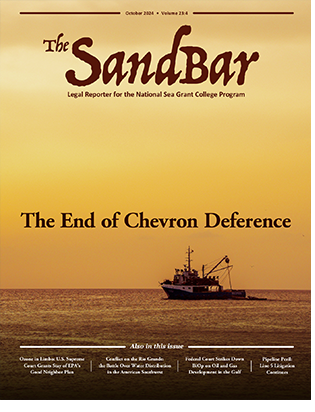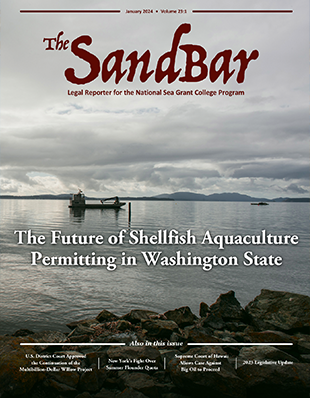The SandBar
- Home
- ▸
- The SandBar
- ▸
- Archives - Volume 23
The SandBar - Volume 23
Issue 4 • October 2024

The End of Chevron Deference
Also in this issue:
• Ozone in Limbo: U.S. Supreme Court Grants Stay of EPA's Good Neighbor Plan
• Conflict on the Rio Grande: the Battle Over Water Distribution in the American Southwest
• Federal Court Strikes Down BiOp on Oil and Gas Development in the Gulf
• Pipeline Peril: Line 5 Litigation Continues
Issue 3 • July 2024

The End of Juliana and the Youth Climate Justice Movement?
Also in this issue:
• The Ebb and Flow of Legal Protections
for Biscayne National Park
• Coral Reefs and Commerce: Concerns
with Dredging in San Juan Bay
• ITLOS Issues Climate Change Advisory
Opinion
• At Home in the Arctic: Alaska’s
Attempt to De‐List a Threatened Seal
is Struck Down
Issue 2 • April 2024
Loper: The Death Knell for Chevron Deference?
Also in this issue:
• Court Gives Green Light to Challenge to Texas Beach Closures Due to Space Flights
• Court Revokes Florida’s CWA § 404 Permitting Program
• Anchoring Change: Bar Harbor Restricts Cruise Ship Visitors to 1,000 Per Day
• Setting Sail for Sustainability:
EPA Agrees to Finalize Ballast Water Discharge Standards
Issue 1 • January 2024
The Future of Shellfish Aquaculture Permitting in Washington State
Also in this issue:
• U.S. District Court Approved the Continuation of the Multibillion-Dollar Willow Project
• New York's Fight Over Summer Flounder Quota
• Supreme Court of Hawaii Allows Case Against Big Oil to Proceed
• 2023 Legislative Update
Sea Grant Law Reporter is a result of research sponsored in part by the National Oceanic and Atmospheric Administration, U.S. Department of Commerce, under Grant Number NA06OAR4170078, the Sea Grant Law Center, Mississippi Law Research Institute, and University of Mississippi Law Center. The U.S. Government and the Sea Grant College Program are authorized to produce and distribute reprints notwithstanding any copyright notation that may appear hereon. The views expressed herein are those of the authors and do not necessarily reflect the views of NOAA or any of its sub-agencies.
Subscribe to The SandBar
Subscribe to be notified by email when a new issue of The SandBar is available.












